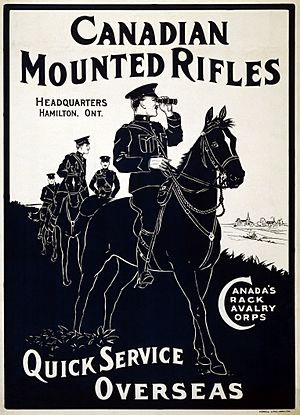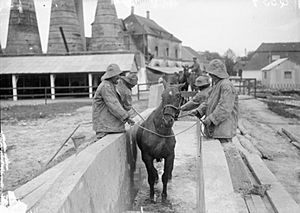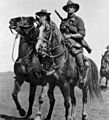Horses in World War I facts for kids
Horses played a huge role in World War I (1914–1918). They were incredibly important for armies, helping with many tasks. But life for these horses was very tough. They faced dangers like gunfire, poison gas, and terrible diseases. Hundreds of thousands of horses died during the war. Many others were treated in hospitals and sent back to the front lines.
Armies used horses for many things. They were better than early trucks at moving through deep mud and rough ground. Horses helped with scouting, carrying messages, and pulling heavy things. These included artillery (big guns), ambulances, and supply wagons. Horses also helped boost the spirits of soldiers. However, having so many animals together could also spread diseases and make camps dirty.
Horses became so valuable that by 1917, some soldiers were told losing a horse was worse than losing a person. This shows how important they were to the war effort. Germany, for example, struggled to replace its lost horses because of a blockade. This shortage of horses even contributed to Germany's defeat.
Contents
Horses in Battle: Cavalry
At the start of World War I, most armies still had groups of soldiers who fought on horseback, called cavalry. Even before the war, some military experts in Britain realized that new technology, like machine guns, meant that cavalry charges were becoming less useful.
However, many senior cavalry officers disagreed. They kept their cavalry units ready throughout the war, even though they were rarely used in big battles. Valuable wartime supplies were spent on training and keeping these horse units. Sadly, when cavalry charges were attempted, many soldiers and horses were lost in attacks against machine guns.
Horses Helping Out: Logistical Support
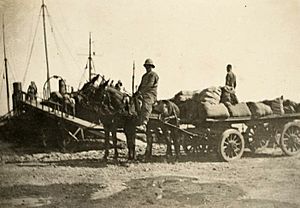
Horses were used a lot for moving supplies and equipment for the military. They pulled ambulances, carried food, and moved ammunition. At the beginning of the war, the German army relied on horses to pull their field kitchens and wagons full of artillery shells.
The Royal Corps of Signals used horses to pull wagons carrying communication cables. Messengers on horseback, called dispatch riders, were crucial for quickly sending information. Horses also pulled heavy artillery guns, and calm, steady animals were very important for the guns to work well.
In some parts of the front, deep mud was a huge problem because drainage systems were destroyed. This made horses and mules absolutely vital. They were often the only way to get supplies to the front lines and move big guns from one place to another. After the Battle of Vimy Ridge in April 1917, one Canadian soldier remembered how horses were "up to their bellies in mud." Many had to be shot because they got stuck.
Thousands of horses were needed to pull field guns; it took six to twelve horses for each gun. During the Battle of Cambrai, horses were even used to rescue guns that the British had captured from the enemy. In one amazing story, two teams of sixteen horses each had their hooves and chains wrapped to make less noise. They successfully pulled out two guns, jumping over a trench and waiting out enemy shelling.
Sometimes, fake horses were used to trick the enemy about where troops were located. There is also some evidence that Germans used horses in experiments with chemical and biological warfare. German agents were suspected of infecting horses and cattle heading for France with a disease called glanders. This disease can spread to humans and was also used against the Russians to stop them from moving their artillery.
The importance of horses was well known. In 1917, during the Battle of Passchendaele, soldiers understood that "to lose a horse was worse than losing a man." This was because men could be replaced, but horses were much harder to find.
Horse Casualties and Care
About 25 percent of all horse deaths in the war between 1914 and 1916 were due to battle. The rest died from diseases or exhaustion. The highest death rates were in East Africa. In 1916 alone, 290% of the initial horses died there, mostly from infections like the tsetse fly disease.
On average, Britain lost about 15 percent of its military horses each year of the war. This included those killed, missing, or abandoned. In the French war zone, losses were about 17 percent. This was much lower than in earlier wars like the Crimean War (80 percent losses) or the Boer War (120 percent losses).
Remembering the Horses: Legacy
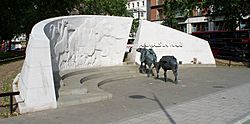
Horses are the animals most connected with World War I. Many memorials have been built to honor their service. One at St. Jude on the Hill in Hampstead has the words: "Most obediently and often most painfully they died—faithful unto death."
The Animals in War Memorial in London remembers all animals, including horses, who served and died with British and allied forces. Its inscription says: "Animals In War. This monument is dedicated to all the animals that served and died alongside British and allied forces in wars and campaigns throughout time. They had no choice." In Minneapolis, a monument near Lake of the Isles honors the horses of the Minnesota 151st Field Artillery that died in World War I.
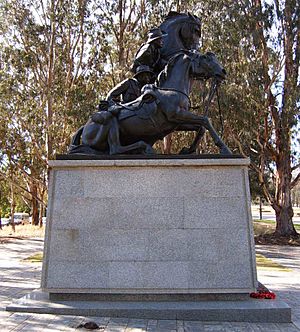
The Desert Mounted Corps Memorial in Canberra, Australia, remembers the men and horses of the Australian Light Horse Brigade and New Zealand Mounted Rifles. These soldiers and their horses died between 1916 and 1918 in Egypt, Palestine, and Syria. A piece from the original memorial, a broken horse's head, is now part of an exhibition honoring animals in the Australian military. This exhibition also features the preserved head of Sandy, the only horse to return to Australia after the war.
Many artists created works showing horses in World War I. War artist Alfred Munnings went to France in 1918 as an official war artist. He drew and painted horses working with the Canadian Cavalry Brigade and the Canadian Forestry Corps. Forty-five of his paintings, many featuring horses, were shown at the Canadian War Records Exhibition. Other artists like Umberto Boccioni and Terence Cuneo also painted horses in war. During the war, artist Fortunino Matania created the famous image Goodbye Old Man, which was used to raise awareness about animal suffering.
Soldiers from many countries wrote poetry to pass the time, and horses often appeared in these poems. In 1982, Michael Morpurgo wrote the novel War Horse. This book tells the story of a cavalry horse during the war. It was later turned into a very successful play and a movie, released in 2011.
Images for kids
-
The 20th Deccan Horse drawn up in ranks during the Battle of Bazentin Ridge, 1916
-
Members of the Canadian Cavalry Brigade perform a cavalry charge during the Battle of Moreuil Wood.
-
French horsemen crossing a river on their way to Verdun.
See also
 In Spanish: Caballos en la Primera Guerra Mundial para niños
In Spanish: Caballos en la Primera Guerra Mundial para niños
- Australian Light Horse
- Horses in warfare


